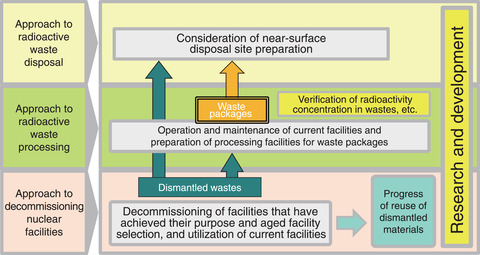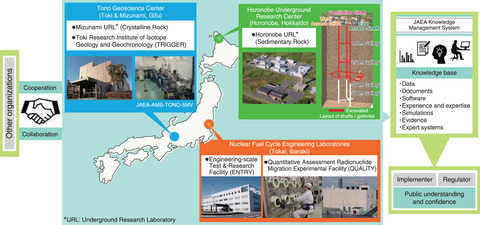
Fig.8-1 Outline of low-level radioactive waste management

Fig.8-2 Schematic view of the basic concept for the geological disposal of high-level waste

Fig.8-3 Structure of JAEA R&D activities
Toward Decommissioning Nuclear Facilities and Managing Radioactive Waste
To maintain and develop its research and development (R&D) capabilities by strengthening the safety of its nuclear facilities and ensuring steady implementation of back-end measures, JAEA issues the “Medium- and Long-Term Management Plan of our Facilities” (issued on April 1, 2017, and amended on April 1, 2020) as a comprehensive plan detailing the following three points:
• The selection and consolidation of facilities,
• safety measures, and
• the management of back-end issues.
In the plan, 89 nuclear facilities were chosen to be decommissioned.
Among the large facilities, JAEA submitted an application to the Nuclear Regulation Authority (NRA) for permission to decommission MONJU and the Tokai Reprocessing Plant (TRP), which led to the NRA granting permission for the decommissioning of MONJU on March 28, 2018 and for that of TRP on June 13, 2018. The application to the NRA for permission to decommission the Uranium Enrichment Demonstration Plant is ongoing.
The implementation of back-end measures requires long-term prospects and policies, including those regarding the processing and disposal of radioactive waste; the decommissioning of TRP is expected to take approximately 70 years to complete. Therefore, JAEA published a long-term prospect and policy for back-end measures, the “Back-end Roadmap”, on December 26, 2018.
To ensure safe and appropriate nuclear facility decommissioning and radioactive waste management, it is necessary to introduce new technologies and knowledge and to promote the development of technologies for advanced safety and cost reduction. Technologies for the safe and effective dismantling of nuclear facilities, the minimization and stabilization of radioactive wastes, and the disposal of radioactive wastes are under development (Fig.8-1). The proposed disposal project applies to low-level radioactive wastes from research facilities of universities, private organizations, and JAEA facilities.
TRP has entered the decommissioning stage. In the TRP, in an effort to reduce risk to the facilities, the vitrification of high-level radioactive waste (HLW) is promoted with a primary focus on safety. JAEA has also developed advanced vitrification techniques.
Specifically, this year saw the making of the “Radioactivity Concentration Equivalent Dose Criteria” as important nuclide selection criteria for smooth implementation of low-level radioactive waste disposal projects generated at research facilities, etc. (Topic 8-1), development of a technique for recovering nuclear material from used extraction solvent using solid adsorbent (Topic 8-2), investigation of radioactive aluminum waste treatment technology using the Bayer process aimed at converting difficult-to-treat waste into a stable waste package (Topic 8-3), and the development of a fireproof sheet on glove box panels toward safety improvement of plutonium handling facilities (Topic 8-4).
R&D to Improve Technology and Reliability of Geological Disposal in Japan
Geological disposal is internationally recognized as the most practical method currently available for the long-term isolation of HLW, which is produced during the generation of nuclear power, from human environments. This critical issue must be approached sensibly by the present generation and will remain crucial regardless of any revision of the national nuclear energy policy.
In Japan, the spent fuel discharged from a nuclear reactor is reprocessed to extract the reusable uranium and plutonium for power generation. The liquids separated from the spent fuel during chemical reprocessing are consolidated into a stable glass form. In accordance with the Japanese disposal policy, vitrified waste is then encapsulated in a thick steel overpack, surrounded by highly compacted bentonite, and emplaced in a stable geological environment at a depth of more than 300 m below the surface (Fig.8-2).
R&D in relevant fields such as geoscience, repository engineering, and safety assessments of the disposal system are ongoing, as summarized in Fig.8-3, and are vital in improving their sound technical basis and be reflected in the implementation and regulatory activities.
The Horonobe Underground Research Center for sedimentary rock carries out R&D including Study on near-field system performance in geological environment (Topics 8-5 and 8-6).
At the Tono Geoscience Center, the Toki Research Institute of Isotope Geology and Geochronology is engaged in a study of the long-term stability of the geological environment (Topics 8-7 and 8-8), while the Mizunami Underground Research Laboratory project for crystalline rock is continuing work on the backfilling of underground facilities.
To expand further the knowledge regarding geological disposal, extensive studies to assess the behavior of the engineered barrier system, and key processes constraining the release and the migration of radionuclides are being studied (Topics 8-9 and 8-10). These studies exploit the data regarding geological environments that were obtained through geoscientific research at underground research laboratories.
Results of the R&D activities have been summarized as a web-based report (CoolRep), which has been made available on JAEA's public website:
CoolRep: https://kms1.jaea.go.jp/CoolRep/english.html.